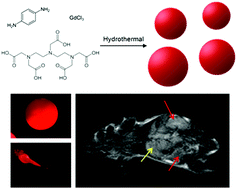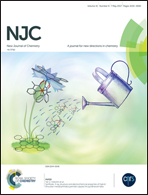Red fluorescence-magnetic resonance dual modality imaging applications of gadolinium containing carbon quantum dots with excitation independent emission
Abstract
Red fluorescence emission and functionality are critically required for the development and applications of carbon quantum dots (CQDs), as most CQDs show blue and green excitation dependent emissions. In this research, gadolinium (Gd) containing CQDs were prepared with p-phenylenediamine, diethylene triamine pentaacetic acid (DTPA), and Gd3+ ions as the precursors using a simple hydrothermal strategy. The hybrid CQDs showed excitation independent red fluorescence. Using DTPA–Gd it was possible to functionalize hybrid CQDs with a magnetic resonance (MR) response. The red fluorescence and biocompatibility of the CQDs were validated using HepG2 (liver hepatocellular carcinoma) cells, zebrafish embryos and larvae as models. The hybrid CQDs did not interfere with the development of zebrafish embryos and the different affinity of the CQDs towards the different tissues of the embryos and larvae was clearly observed. Fluorescence and MR images were recorded using mice as the model. While the liver and kidney of the mice were clearly outlined on the MR image, the red fluorescence could penetrate the skin of mice easily. Further strategies that tune the emission, especially the red and the near-infrared emission, functionalize the CQDs using an easy procedure, and improve the quantum yield of CQDs, are still needed to promote their development and applications.



 Please wait while we load your content...
Please wait while we load your content...